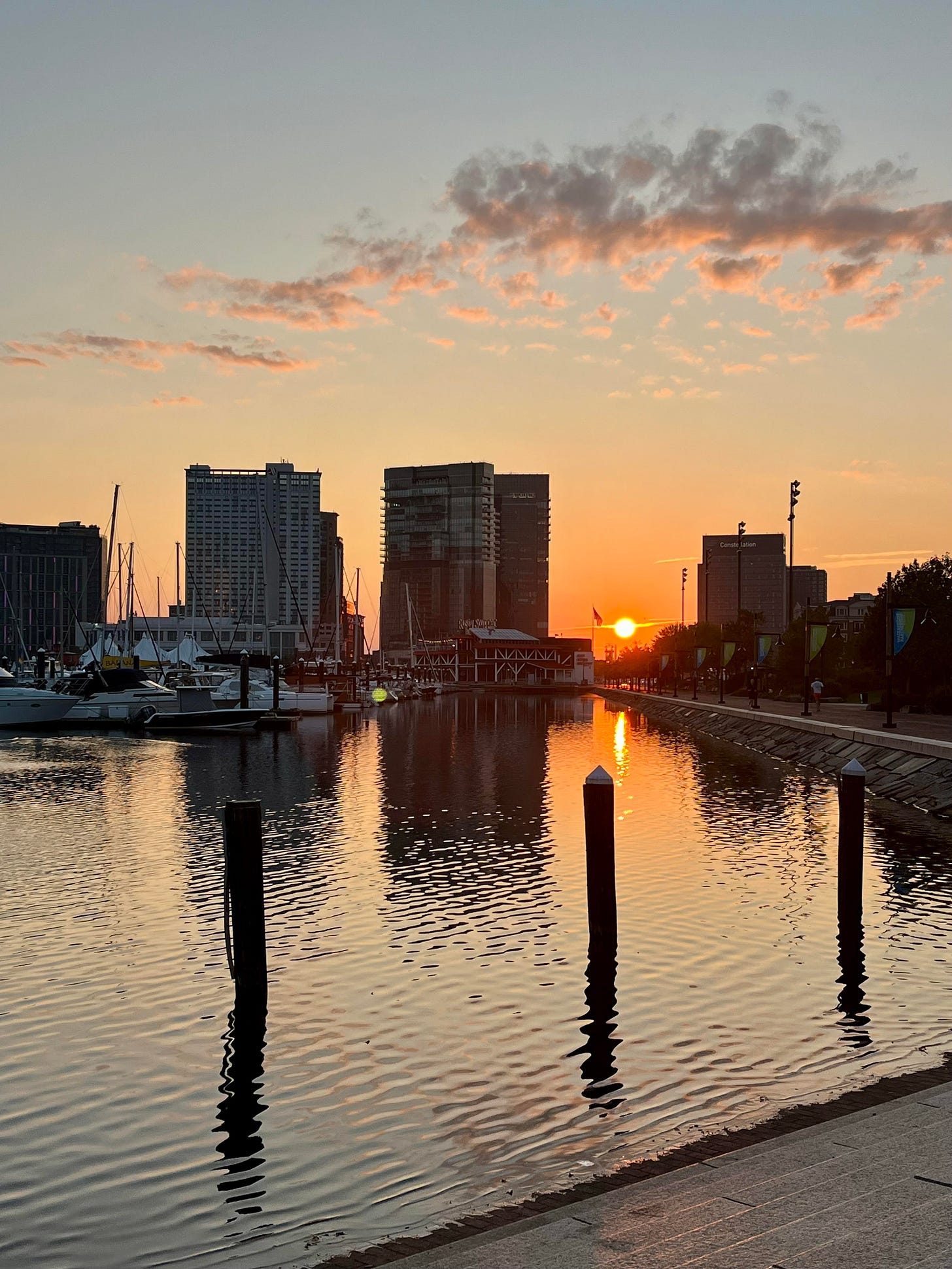Reflections on The Federalist Program (Empire of Liberty #1)
Alexander Hamilton's plans for America.
I photographed the Inner Harbor as the sun lowered into the distant horizon. Standing before the Maryland Science Center, I thought about times I would visit the building as a child and adult. It has been a staple of my life, but that can’t be said for every generation. The Maryland Science Center began as one of the centerpieces in Baltimore’s mid-century overhaul of its Inner Harbor. Sitting along an estuary leading into the Chesapeake Bay, this beautiful commercial center was not always a tourist hub. There were idle piers and old warehouses before the commercial establishments we know today arrived.
As the economy changed, the area began to resemble deindustrialization, with abandoned warehouses and idle piers. Thus, a private-public partnership moved forward with a plan to recreate the port into an entertainment district and spend money to create a wave of popular attractions that could improve the city’s tax base.
Developers worked closely with municipal and state governments to centrally plan the new harbor, which included the Maryland Science Center, the Convention Center, Harborplace, and the National Aquarium. High-profile investment emanated from James Rouse of the Rouse Company and Marriott International. There was also funding from the city’s municipal government and urban renewal grants from Housing and Urban Development (HUD). The Inner Harbor benefitted from tax-incremental funding (TIF), which relies on revenue from increased property values, with the downside being that former residents are priced out. The method has its fair share of praise and criticism.
My experience with the harbor has evolved over my lifetime. It began as a place of wonder with all of its kid-friendly attractions. Today, it is a place I explore from the perspective of a curious local citizen reflecting on the place he inhabits. In so many ways, my exploration of this familiar locale reflects the themes of my current choice of reading. In Gordon Wood’s Empire of Liberty, he explores the panoply of forces melding together a recently liberated America in its early governing period. So far, I am at the beginning of the Adams presidency as the international embers of the French Revolution travel across the Atlantic into the United States.
At this point in the book, Alexander Hamilton, the first Secretary of the Treasury, envisions a modern state modeled after the financialization of English society. Hamilton’s plan was implemented despite growing opposition from the first Secretary of State, Thomas Jefferson, and the first Speaker of the House of Representatives, James Madison. Hamilton’s position became the official position of the Federalist Party. In the beginning, Congress had enough faith in Hamilton’s acumen to suspend the Ways and Means Committee because Hamilton was drafting federal spending plans.
At the end of the Revolutionary War, the U.S. was racked with debt at the state and federal levels. Hamilton planned to repurpose that debt through the federal government’s purchase of debt owed by the states. This inevitably angered representatives of Virginia and other states who had already paid off their debts. Prominent voices against the debt plan felt that the people benefitting were financial speculators who bought bonds at reduced prices and could get their losses written off by the federal government. Supporters of the debt plan felt that a strong central government with financial power was essential to national growth and credit creation.
The debt plan was coupled with Hamilton’s urgency for establishing a national bank. The idea was that this bank could spur development and commerce by increasing the federal government’s access to credit. Opponents of the bank plan felt that it institutionalized the ability of a financial class to rise with the aid of an inevitably corrupt bank. Thomas Jefferson and James Madison famously opposed the bank plan, arguing it was unconstitutional. Hamilton rebutted this line of attack using the Necessary and Proper Clause, which ruled that Congress could enact legislation that it, as an institution, felt was essential to the national well-being.
Hamilton’s debt plan succeeded because of a bargain with debt-free states to move the national capital to the designated region between Maryland and Virginia. Although the Constitution was only a few years old, the regional divides were already heating up.
The Federalist program coincided with emphasizing the creation of manufacturing hubs alongside agricultural ones, including protective tariffs. Gordon describes Hamilton’s approach as studying Great Britain’s transformation after the English Civil War:
“More than any American, [Hamilton] saw England’s eigteenth-century experience as an object lesson for the United States, and he deliberately set out to duplicate England’s great acheivements in political economy and public policy.
By the eighteenth century England had emerged from the chaos and civil wars of the seventeenth century, which had killed one king and deposed another, to become the dominant political and commercial power in the world. That this small island on the northern edge of Europe with a third of the population of continental France was able to build the greatest and richest empire since the fall of Rome was the miracle of the age. The eighteenth-century English ‘fiscal-military’ state, in historian John Brewer’s apt term, could mobilize wealth and wage war as no other state in history ever had. Its centralized administration rested on its bureacratic ability to acquire and use knowledge, and it had developed an extraordinary capacity to tax and to borrow from its subjects without impoverishing them.
Hamilton saw that the secret of England’s success was its system of funded debt together with its banking structure and its market in public securities. By attempting to duplicate the English experience, Hamilton was flying in the face of several generations of bitter intellectual opposition to the commercialization of British society and the corruption of British politics.”
Hamilton’s plan is the foundation of the modern American economy, even though the existence of a national bank would remain a fraught issue. What strikes me most is that Hamilton’s dream was not fully realized in his lifetime. Still, after America’s experience with its Civil War, it would rise from the ashes under a similar commercialization and favor the plans of Hamilton’s ghost. Ultimately, the American state would perfect the model of a commercial empire in the 20th century and surpass its former colonizer.
From a modern standpoint, state-sponsored economic intervention favors more left-leaning ideologies and positions. But this was the conservative view at the time, mainly because it was deeply connected to a sense among the Federalists that government should only be run by disinterested gentlemen who are bred to understand the sophisticated art of statecraft. It was a profoundly elitist view. Accusations of Hamilton being a monarchist were also not uncommon, and the Federalists would often talk of monarchical republicanism. Such was the imagination of statesmen of the late 18th century and early 19th century. Indeed, many of the Federalists favored a strong executive.
The Federalist program is deeply connected to the structures that would become a mainstay in the industrial northern states and, eventually, the nation.
Baltimore’s Inner Harbor manifests an economy built on modern networks requiring credit and state intervention. It emanates the power that Alexander Hamilton envisioned for America.









I wish to talk a little bit about Hamilton. You touched on it but didn't mention it by name his Report on Manufactures, The gist of which was to use tariffs to force Americans to industrialize.
He evidently got this idea from Henry VII. H7 on taking the crown from Richard III's wounded head, found that the nation he so coveted was the armpit of Europe. Roads were impassable and pot holes, when it rained would drown an ox cart.
At that time England's principle export was raw dyed wool. It imported everything, silver, glass ware, silk, linen even textiles.
So Henry7, levied tariffs on export of raw wool and import of fine goods, that forced the English like my 14th great grandfather a dyer of wool, and recipient of a land grant for marrying a daughter pregnant with the child of a noble. (not my ancestor, poor dude lost his head to H7)
My ancestor was a wool dyer, by the time he died he was the patriarch of dynastybased on wool, and subsequently textile mills through the length and breadth of England as well as much land and messauges he rented and leased.
His tariff's on imports forced the English to develop their own industries, and he was so successful that his son was able to built the largest battleship of all times, the Mary Rose, with over 100 brass cannons, and a castle (None such) for his child bride Catherine Howard.
All you have to do is compare a painting of Henry 7 to that of his son. Father is dressed like a commoner in his sons court, and England was so prosperous that the son of a commoner could get a university education and serve on Henry VIII's privy council.
Commoners so wealthy that they blatantly paraded around dressed as nobles, so offended the nobility that Henry VIII passed Sumptuary Laws, limiting the dress and materials of commoners.
But Alex believed in the unitary executive, and one for life as well, that is why Mike Pence went to see the stage performance.
I can imagine Trump seeing himself as the heir to Hamilton
Per wikipedia: Hamilton and his older brother, James Jr.,[7] were born out of wedlock to Rachel Lavien (née Faucette),[b] a married woman of half-British and half-Huguenot descent,[c][16] and James A. Hamilton, a Scotsman and the fourth son of Alexander Hamilton, the laird of Grange, Ayrshire.[17]
Nee means that Faucette was her birth name. The Huguenots were crypto Protestants. Originally of Catalan, instead of converting from Judaism to Catholic, to escape the expulsion edict of Ferdinand and Isabella, they adopted a form of Protestantism, that was then making it's rounds due to one Jean Calvin, nee Cauvin, whose father was George Cauvin nee Cohen),The Huguenots shared with the Calvinists and Orthodox Jews the concept of pre destination, but unlike the Calvinists, they weren't so severe in their manners, dress and lifestyle.
Paul Revere's father, Apollonius Revoire was a Huguenot. The Huguenots were accomplished artists, artisans and silver smiths, and for that reason London Merchants petitioned King William to relieve them of the "unfair competition" that the Huguenots suffered them, so William gave them a 1,000 acre land grant in Virginia, the area recently occupied by the Monacan tribe, who died off of small pox. This town is Manakin Sabot, an independent community inside the city limits of
Richmond, VA
Oh tariffs worked then, but not now in a world of global trade, they can be useful if judiciously and selectively applied, not not as political punishment or statement as is the desire of Trump, the they are counterproductive and an act of economic war.
An added thought on Alexander Hamilton, because he was born in the Caribbean (Nevis, British Leewards) some want to make him out to be mulatto, but Cromwell shipped Irish slaves all over the colonies, including, especially, Nevis and the British leewards
Lavien is an Anglo Norman name, a friend of mine who is Jewish claims it is Levine and calls him Al Levine. This identity politics crap drives me up the wall, so many inferiority complexes, so much contention. Would there be a world of one ethnicity.